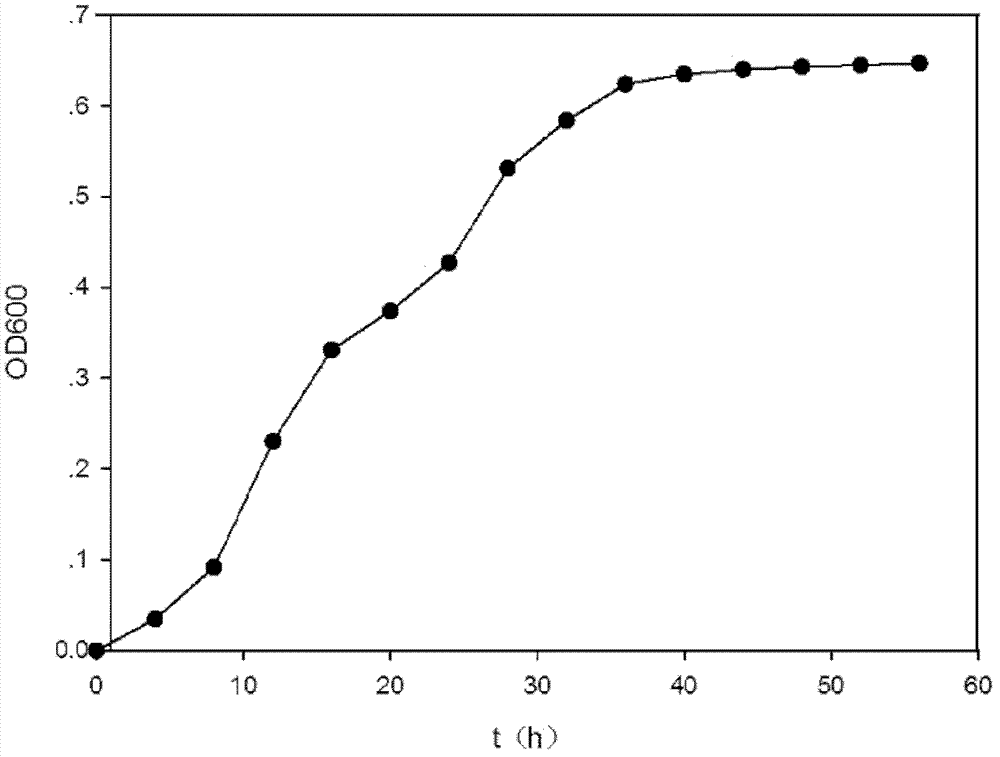High-temperature degrading bacteria and application thereof
A high-temperature degradation and bacterial strain technology, applied in the field of biodegradation and microorganisms, can solve the problems of difficult degradation of organic macromolecules, small number of microorganisms, etc.
- Summary
- Abstract
- Description
- Claims
- Application Information
AI Technical Summary
Problems solved by technology
Method used
Image
Examples
Embodiment 1
[0016] Example 1 Isolation of Geobacillus HN-5
[0017] Collect the filter mud compost samples from Hainan Yuwo Biotechnology Company in Chengmai County, Hainan Province and stack them for 10 days. After several generations of high-temperature acclimation, the bacterial solution was applied on the beef extract peptone (NR) plate by gradient dilution method and cultured at 70°C. , isolate high-temperature-resistant strains, and obtain pure bacteria after several generations of streaking and purification. NR formula: beef extract 5g, peptone 10g, NaCl 5g, agar 15g-20g, water 1000mL, pH 7.4-7.6.
[0018] Inoculate multiple strains of isolated pure bacteria into solid selective medium to identify their degradation ability, and observe whether there is a hydrolysis circle around the colony. If there is a hydrolysis circle, it means that the strain has the ability to degrade the substrate, otherwise, it does not have the degradation ability. ability, and finally obtained a Geobacil...
Embodiment 2
[0024] Example 2 Research on Enzyme Production Ability of Geobacillus HN-5
[0025] Prepare HN-5 seed solution (70°C, cultured in NR liquid medium until the OD value is about 0.4), take 1ml of the seed solution and inoculate it into cellulose, protein, starch fermentation medium (recipe below), and culture at 70°C, After 24 hours, the cellulase activity, amylase activity and protease activity of the strains were measured.
[0026] Cellulose fermentation medium: CMC-Na 5g, NaNO 3 2.5g, KH 2 PO 4 1g, MgSO 4 0.6g, NaCl 0.1g, CaCl 2 0.1g, FeCl 3 0.01g, gelatin 2g, yeast powder 0.1g, H 2 O1000mL, pH 6.8-7.2.
[0027] Starch fermentation medium: 10g soluble starch, 10g peptone, 5g yeast powder, 10g NaCl, pH 7.0, 15g-20g plant gel, 0.05-0.1g Triben blue, H 2 O 1000mL, sterilized at 121°C for 30min.
[0028] Protein fermentation medium: casein 5%, Mandel A salt 10%, Mandel B salt 1%, pH6.0; Mandel A salt: KH 2 PO 4 2g / L, (NH 4 ) 2 SO 4 1.4g / L, MgSO 4 0.3g / L, CaCl...
Embodiment 3
[0033] Example 3 Growth Curve of Geobacillus HN-5
[0034] Take a fresh bacterial culture plate of the bacteria to be tested, pick 1 ring of bacterial lawn by aseptic operation, insert it into a 250ml Erlenmeyer flask containing 100ml of culture solution, and place it at 70°C for static culture for 24h as the seed culture solution. Use a sterile pipette to draw 1ml of seed culture solution into a 250ml Erlenmeyer flask filled with 100ml of sterilized culture solution, and culture at 70°C. Take the culture solution every 4 hours and measure the absorbance value under the 660nm wavelength, take the time as the abscissa, and the OD value as the ordinate to draw the growth curve of the bacterial strain ( image 3 ).
[0035] Experimental results such as image 3 As shown, HN-5 has a short incubation period, enters the logarithmic growth phase soon, and the logarithmic phase lasts longer (≥24h), and the strain stops growing after 36h.
PUM
 Login to View More
Login to View More Abstract
Description
Claims
Application Information
 Login to View More
Login to View More - R&D
- Intellectual Property
- Life Sciences
- Materials
- Tech Scout
- Unparalleled Data Quality
- Higher Quality Content
- 60% Fewer Hallucinations
Browse by: Latest US Patents, China's latest patents, Technical Efficacy Thesaurus, Application Domain, Technology Topic, Popular Technical Reports.
© 2025 PatSnap. All rights reserved.Legal|Privacy policy|Modern Slavery Act Transparency Statement|Sitemap|About US| Contact US: help@patsnap.com



